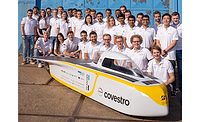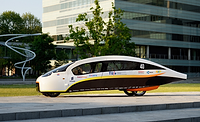WUPPERTAL, Germany - The ThyssenKrupp SunRiser, a solar sports coupé, placed third in the Cruiser Class of this year’s 2015 Bridgestone World Solar Challenge in Australia. The competition was based on solar kilometers travelled, passenger kilometers, speed, energy efficiency and design and practicality. Students at Bochum University of Applied Sciences in Germany, with the support of Axalta Coating Systems, built the car.
The students chose Axalta’s Voltatex® 4250 low-emission, one-component impregnating resin for critical aspects of the electric motors: to insulate and to protect them from the harsh external influences and to improve heat transfer. Voltatex 4250 also offers excellent resistance to liquid chemicals, oil and distilled water. The 2013 team from Bochum also used Voltatex 4250 and placed second that year.
Timo Kelm from the ThyssenKrupp SunRiser team said, “We have worked with Axalta before and were delighted that this year we were again able to take the motors of the car to Axalta’s technical center in Wuppertal, Germany. There, Voltatex 4250 was applied on the SunRiser’s stators, the stationary parts of the electric motors. Although we built a sporty two-seater, the emphasis was very much on functionality and suitability for everyday use. Protecting our electric motors has been a key part of the design.”
Darius Duda, Technical Representative for Voltatex Energy Solutions for Axalta in Europe, Middle East and Africa, said, “We are delighted with the great, well-deserved result the students have achieved with the ThyssenKrupp SunRiser. It was a real pleasure once again to support the Bochum University of Applied Sciences’ SolarCar team with our energy solutions technology and expertise. The low-emission formulation of Voltatex 4250 also dovetails neatly with the World Solar Challenge’s environmental goal, too. We strive to help young talent to develop and to test innovative, sustainable solutions. We are active in supporting students and educational institutions around the world with projects like this.”
For this year’s World Solar Challenge, 46 entries from 25 different countries competed in the biennial 3,000km race from Darwin to Adelaide. The cars in the Cruiser Class had to pass seven checkpoints and, after starting the race fully charged, were only allowed one external battery charge after 1,500km.
For more information on the Bochum University of Applied Science students’ solar car, go to http://bosolarcar.de/. For more information on Axalta Coating Systems, visit Axalta at www.axaltacoatingsystems.com.







Report Abusive Comment